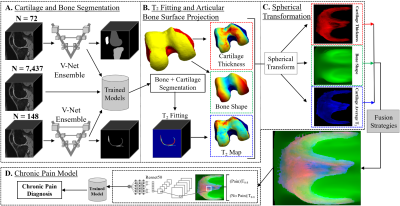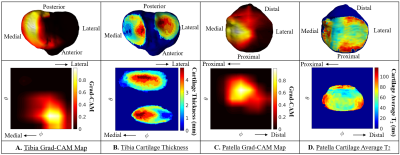Alejandro Morales Martinez1, Jinhee Lee1, Francesco Caliva1, Claudia Iriondo1, Sarthak Kamat1, Sharmila Majumdar1, and Valentina Pedoia1
1UCSF, San Francisco, CA, United States
1UCSF, San Francisco, CA, United States
Multimodal imaging biomarker fusion for training interpretable deep learning models to predict chronic pain in knee OA patients.

Overview of the pipeline. (A) A bone and a cartilage
segmentation model ensemble were trained on manually segmented 3D-DESS and used to segment bone and cartilage from 7,437 3D-DESS. (B)
Bone shape and cartilage thickness maps were obtained from segmentations. Cartilage T2 values were parametrically fitted after registering 3D-DESS
cartilage to matching MSME. Each biomarker was projected onto the articular bone surface and transformed into spherical coordinates (C). (D) The merged spherical maps were used to
train classifier models to diagnose chronic knee pain.

Grad-CAM activation spherical maps overlaid on the articular bone surface for the tibia and patella cartilage thickness and cartilage T2 models respectively. (A) Tibia Grad-CAM spherical map and projection shows a high activation in the medial tibia. (B) Same tibia cartilage thickness spherical map and projection shows cartilage thinning in the medial tibial cartilage. (C) Patella Grad-CAM spherical map and projection shows a high activation in the medial patella. (D) Same patella cartilage T2 spherical map and projection shows elevated T2 values in the medial patellar cartilage.
